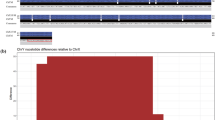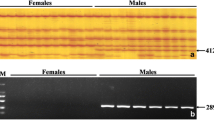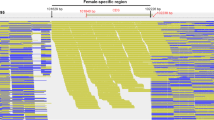Abstract
Sex-specific DNA markers are very helpful for identifying genetic sex and studying sex determination mechanisms in fish. To identify the sex-specific markers of spotted knifejaw (Oplegnathus punctatus), we performed a comparative analysis of the female and male genomes. In this study, an 18 bp insertion was identified in the male genome after verification by sequencing depth and PCR. An effective and rapid method based on PCR was then developed to identify the genetic sex. A male-female-shared primer pair and a male-specific primer were designed for PCR amplification to avoid false-negative phenomena. To examine the primers in practice, we utilized hundreds of spotted knifejaw fish from different groups to identify their genetic sex, and the results were consistent with their phenotypic sex. The male-specific DNA marker would be helpful for artificial breeding, Y chromosome assembly and further study of the sex determination mechanism. This study is the first to identify an effective sex-specific marker in spotted knifejaw.




Similar content being viewed by others
References
Baroiller J-F, D'cotta H (2001) Environment and sex determination in farmed fish. Comp Biochem Physiol Part C Toxicol Pharmacol 130:399–409
Berset-Brändli L, Jaquiéry J, Dubey S, Perrin N (2006) A sex-specific marker reveals male heterogamety in European tree frogs. Mol Biol Evol 23:1104–1106
Brugmans B, Van Der Hulst RG, Visser RG, Lindhout P, Van Eck HJ (2003) A new and versatile method for the successful conversion of AFLP™ markers into simple single locus markers. Nucleic Acids Res 31:e55–e55
Cai M, Zou Y, Xiao S, Li W, Han Z, Han F, Xiao J, Liu F, Wang Z (2019) Chromosome assembly of Collichthys lucidus, a fish of Sciaenidae with a multiple sex chromosome system. Sci Data 6:132
Charlesworth B, Charlesworth D (2000) The degeneration of Y chromosomes. Philos Trans R Soc Lond B Biol Sci 355:1563–1572
Chen S-L, Li J, Deng S-P, Tian Y-S, Wang Q-Y, Zhuang Z-M, Sha Z-X, Xu J-Y (2007) Isolation of female-specific AFLP markers and molecular identification of genetic sex in half-smooth tongue sole (Cynoglossus semilaevis). Mar Biotechnol 9:273–280
Chen S-L, Ji X-S, Shao C-W, Li W-L, Yang J-F, Liang Z, Liao X-L, Xu G-B, Xu Y, Song W-T (2012) Induction of mitogynogenetic diploids and identification of WW super-female using sex-specific SSR markers in half-smooth tongue sole (Cynoglossus semilaevis). Mar Biotechnol 14:120–128
Chen S, Zhang G, Shao C, Huang Q, Liu G, Zhang P, Song W, An N, Chalopin D, Volff JN, Hong Y, Li Q, Sha Z, Zhou H, Xie M, Yu Q, Liu Y, Xiang H, Wang N, Wu K, Yang C, Zhou Q, Liao X, Yang L, Hu Q, Zhang J, Meng L, Jin L, Tian Y, Lian J, Yang J, Miao G, Liu S, Liang Z, Yan F, Li Y, Sun B, Zhang H, Zhu Y, Du M, Zhao Y, Schartl M, Tang Q, Wang J (2014) Whole-genome sequence of a flatfish provides insights into ZW sex chromosome evolution and adaptation to a benthic lifestyle. Nat Genet 46:253–260
Cioffi M, Bertollo L (2010) Initial steps in XY chromosome differentiation in Hoplias malabaricus and the origin of an X 1 X 2 Y sex chromosome system in this fish group. Heredity 105:554
De Almeida-Toledo LF, Daniel-Silva MDFZ, Lopes C, Toledo-Filho SDA (2000) Sex chromosome evolution in fish. II. Second occurrence of an X1X2Y sex chromosome system in Gymnotiformes. Chromosom Res 8:335–340
Devlin RH, Nagahama Y (2002) Sex determination and sex differentiation in fish: an overview of genetic, physiological, and environmental influences. Aquaculture 208:191–364
Du X, Wang B, Liu X, Liu X, He Y, Zhang Q, Wang X (2017) Comparative transcriptome analysis of ovary and testis reveals potential sex-related genes and pathways in spotted knifejaw Oplegnathus punctatus. Gene 637:203–210
Ennis S, Gallagher T (1994) A PCR-based sex-determination assay in cattle based on the bovine amelogenin locus. Anim Genet 25:425–427
Felip A, Young WP, Wheeler PA, Thorgaard GH (2005) An AFLP-based approach for the identification of sex-linked markers in rainbow trout (Oncorhynchus mykiss). Aquaculture 247:35–43
Fowler BL, Buonaccorsi VP (2016) Genomic characterization of sex-identification markers in Sebastes carnatus and Sebastes chrysomelas rockfishes. Mol Ecol 25:2165–2175
Fuji K, Yoshida K, Hattori K, Ozaki A, Araki K, Okauchi M, Kubota S, Okamoto N, Sakamoto T (2010) Identification of the sex-linked locus in yellowtail, Seriola quinqueradiata. Aquaculture 308:S51–S55
Galindo HM, Loher T, Hauser L (2011) Genetic sex identification and the potential evolution of sex determination in Pacific halibut (Hippoglossus stenolepis). Mar Biotechnol 13:1027–1037
Guerrero Iii RD (1975) Use of androgens for the production of all-male Tilapia aurea (Steindachner). Trans Am Fish Soc 104:342–348
Imsland A, Folkvord A, Grung G, Stefansson S, Taranger G (1997) Sexual dimorphism in growth and maturation of turbot, Scophthalmus maximus (Rafinesque, 1810). Aquac Res 28:101–114
Ji X, Chen S, Ma H, Jiang Y, Yang J, Dong X (2010) Natural sex reversal of female Cynoglossus semilaevis in rearing populations. J Fish China 34:322–327
Kawato Y, Yamashita H, Yuasa K, Miwa S, Nakajima K (2017) Development of a highly permissive cell line from spotted knifejaw (Oplegnathus punctatus) for red sea bream iridovirus. Aquaculture 473:291–298
Kearse M, Moir R, Wilson A, Stones-Havas S, Cheung M, Sturrock S, Buxton S, Cooper A, Markowitz S, Duran C, Thierer T, Ashton B, Meintjes P, Drummond A (2012) Geneious basic: an integrated and extendable desktop software platform for the organization and analysis of sequence data. Bioinformatics 28:1647–1649
Kikuchi K, Hamaguchi S (2013) Novel sex-determining genes in fish and sex chromosome evolution. Dev Dyn 242:339–353
Kobayashi Y, Nagahama Y, Nakamura M (2013) Diversity and plasticity of sex determination and differentiation in fishes. Sex Dev 7:115–125
Kovács B, Egedi S, Bártfai R, Orbán L (2000) Male-specific DNA markers from African catfish (Clarias gariepinus). Genetica 110:267–276
Li H, Durbin R (2010) Fast and accurate long-read alignment with Burrows–Wheeler transform. Bioinformatics 26:589–595
Li H, Handsaker B, Wysoker A, Fennell T, Ruan J, Homer N, Marth G, Abecasis G, Durbin R (2009) The sequence alignment/map format and SAMtools. Bioinformatics 25:2078–2079
Li P, Cao D, Liu X, Wang Y, Yu H, Li X, Zhang Q, Wang X (2016) Karyotype analysis and ribosomal gene localization of spotted knifejaw Oplegnathus punctatus. Genet Mol Res 15:gmr15049159
Lin A, Xiao S, Xu S, Ye K, Lin X, Sun S, Wang Z (2017) Identification of a male-specific DNA marker in the large yellow croaker (Larimichthys crocea). Aquaculture 480:116–122
Mei J, Gui J-F (2015) Genetic basis and biotechnological manipulation of sexual dimorphism and sex determination in fish. Sci China Life Sci 58:124–136
Pennell MW, Kirkpatrick M, Otto SP, Vamosi JC, Peichel CL, Valenzuela N, Kitano J (2015) Y fuse? Sex chromosome fusions in fishes and reptiles. PLoS Genet 11:e1005237
Robinson JT, Thorvaldsdóttir H, Winckler W, Guttman M, Lander ES, Getz G, Mesirov JP (2011) Integrative genomics viewer. Nat Biotechnol 29:24
Sun XX, Xu DD, Lou B, Li SL, Zhan W, Zhang YR, Xin J (2013) Development and characterization of novel microsatellite markers in the rock bream fish Oplegnathus fasciatus. Genet Mol Res 12:6462–6465
Székely T, Weissing FJ, Komdeur J (2014) Adult sex ratio variation: implications for breeding system evolution. J Evol Biol 27:1500–1512
Wallace RB, Pal BK, Ugozzoli LA, Wu DY (1997) Allele specific polymerase chain reaction. Google Patents
Woram RA, Gharbi K, Sakamoto T, Hoyheim B, Holm L-E, Naish K, Mcgowan C, Ferguson MM, Phillips RB, Stein J (2003) Comparative genome analysis of the primary sex-determining locus in salmonid fishes. Genome Res 13:272–280
Xiao Y, Xiao Z, Ma D, Liu J, Li J (2019) Genome sequence of the barred knifejaw Oplegnathus fasciatus (Temminck & Schlegel, 1844): the first chromosome-level draft genome in the family Oplegnathidae. Gigascience 8. https://doi.org/10.1093/gigascience/giz013
Xu D, Lou B, Xu H, Li S, Geng Z (2013) Isolation and characterization of male-specific DNA markers in the rock bream Oplegnathus fasciatus. Mar Biotechnol 15:221–229
Xu D, Sember A, Zhu Q, Oliveira EA, Liehr T, Al-Rikabi ABH, Xiao Z, Song H, Cioffi MB (2019) Deciphering the origin and evolution of the X1X2Y system in two closely-related Oplegnathus species (Oplegnathidae and Centrarchiformes). Int J Mol Sci 20. https://doi.org/10.3390/ijms20143571
Funding
This work was supported by grants from the Special Scientific Research Funds for Central Non-profit Institutes, Yellow Sea Fisheries Research Institute (20603022019018), AoShan Talents Cultivation Program Supported by Qingdao National Laboratory for Marine Science and Technology (No.2017ASTCP-OS15), the Taishan Scholar Climbing Project Fund of Shandong, China.
Author information
Authors and Affiliations
Corresponding author
Ethics declarations
Conflict of Interest
The authors declare that they have no conflict of interest.
Additional information
Publisher’s Note
Springer Nature remains neutral with regard to jurisdictional claims in published maps and institutional affiliations.
Rights and permissions
About this article
Cite this article
Li, M., Xu, H., Xu, W. et al. Isolation of a Male-Specific Molecular Marker and Development of a Genetic Sex Identification Technique in Spotted Knifejaw (Oplegnathus punctatus). Mar Biotechnol 22, 467–474 (2020). https://doi.org/10.1007/s10126-020-09966-3
Received:
Accepted:
Published:
Issue Date:
DOI: https://doi.org/10.1007/s10126-020-09966-3




